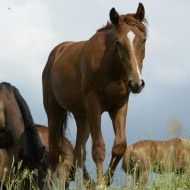
Science and education journals pool resources to establish industry reference point
A free online resource on equine endocrinology has been created in a bid to raise awareness of common disorders and to provide vets with references in one place.
Equine Veterinary Education (EVE) and Equine Veterinary Journal have come together to create the online collection of all of their recent articles on equine endocrinology.
The online resource includes review articles on insulin dysregulation, glucocorticoids and laminitis, and paraneoplastic syndromes.
The project has been made possible with the support of the British Equine Veterinary Association Trust and has been compiled by leading international authorities on equine endocrinology – Prof Philip Johnson of the University of Missouri and Prof Nicholas Frank of Tufts University, Boston and the University of Nottingham.
Disorders such as Pituitary par intermedia dysfunction (PPID) are being identified earlier and treated due to ongoing research and scientific advances.
PPID is a progressive neurodegenerative condition. It is more easily recognised in its advanced form in older horses. Also referred to as Cushing’s Syndrome, it is one of the most common equine endocrine disorders – surveys show a PPID prevalence rate of up to 22% in horses over the age of 15. From this age, the chances of a horse developing PPID then increases by around 20 per cent year on year.
Insulin dysregulation (ID), with increased insulin response to oral sugars, hyperinsulinaemia and insulin resistance, is identified in both PPID and equine metabolic syndrome (EMS). Both PPID and EMS have been linked to the development of recurrent laminitis with subsequent high risk of death.
Professors Nick Frank and Ray Geor give their view of best practice for the management of EMS in the December issue of EVE. They state the first goal is to reduce your horse's weight and offer guidelines for designing equine diets. Exercise and dietary management have been shown to reduce the clinical signs of inflammation in equine metabolic syndrome although further studies are needed to quantify long-term outcomes.
The online collection also includes studies addressing the diagnosis of PPID. Professors Frank and Geor advocate plasma adrenocorticotropin hormone (ACTH) as the most readily accessible test for monitoring PPID cases in a field setting, although they say the thyrotropin- releasing hormone (TRH) stimulation test is more sensitive and has advantages when diagnosing PPID in its early stages.
Pergolide has become the favoured drug for treatment of PPID. While many vets recommend the early introduction of medication in the hope that it may avert laminitis, at present, there are no trials comparing pergolide with alternatives. There has also been no long-term studies to show that horses treated with pergolide before the onset of clinical signs of PPID, have better outcomes including a reduced incidence of laminitis, than horses in which treatment is delayed until clinical signs are apparent.
“Better control of PPID and insulin dysregulation should lower the risk of laminitis to help improve the health and longevity of many predisposed horses and ponies,” said Prof Celia Marr, Editor of Equine Veterinary Journal.
“Raising awareness of the benefits of early diagnosis and sharing the latest research on these and other associated conditions are imperative to provide horse owners with the best diagnostic and treatment programmes for their horses.
"However, it is easy to under-estimate obesity: horse owners need to think about improving management of their horses’ feeding and exercise in order to avert problems before they become a veterinary issue.”
To visit the website click here



 BSAVA is to partner with BVA Live (11-12 June 2026) to champion clinical research.
BSAVA is to partner with BVA Live (11-12 June 2026) to champion clinical research.